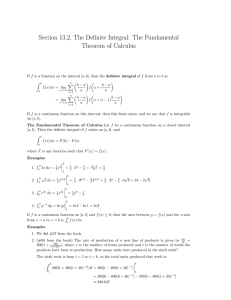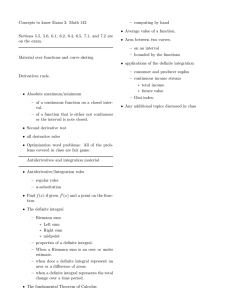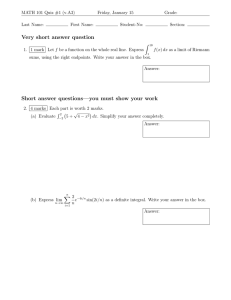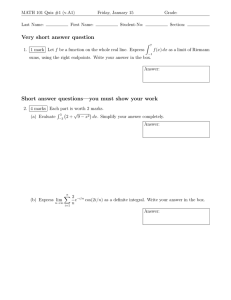5.2 The Definite Integral
advertisement
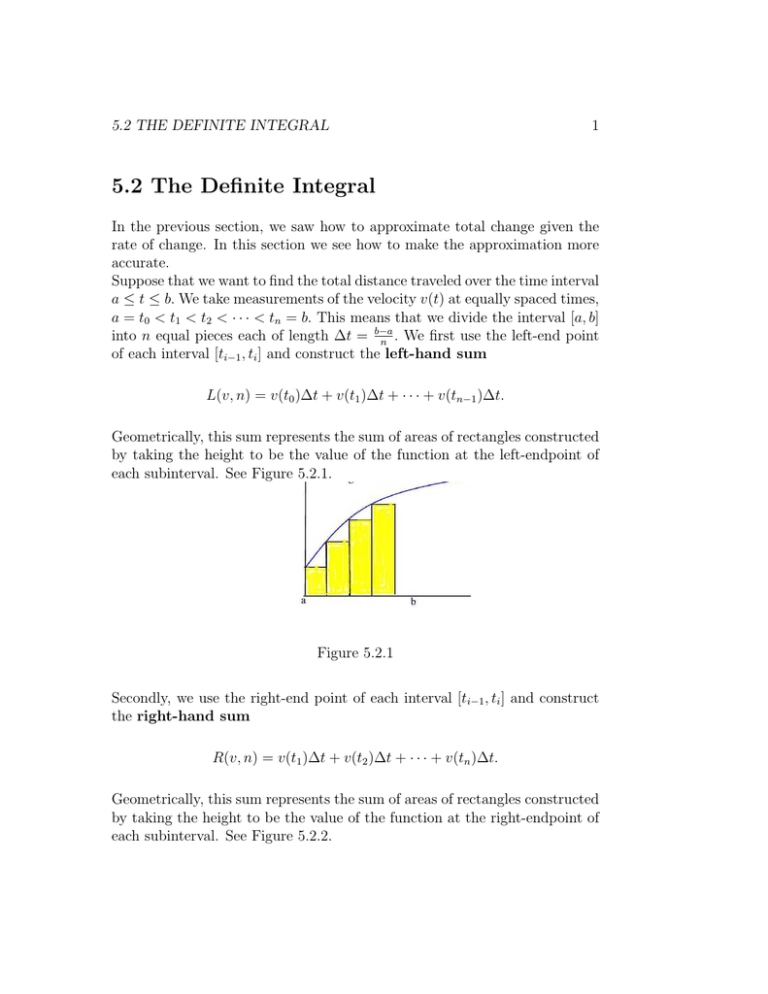
5.2 THE DEFINITE INTEGRAL 1 5.2 The Definite Integral In the previous section, we saw how to approximate total change given the rate of change. In this section we see how to make the approximation more accurate. Suppose that we want to find the total distance traveled over the time interval a ≤ t ≤ b. We take measurements of the velocity v(t) at equally spaced times, a = t0 < t1 < t2 < · · · < tn = b. This means that we divide the interval [a, b] . We first use the left-end point into n equal pieces each of length ∆t = b−a n of each interval [ti−1 , ti ] and construct the left-hand sum L(v, n) = v(t0 )∆t + v(t1 )∆t + · · · + v(tn−1 )∆t. Geometrically, this sum represents the sum of areas of rectangles constructed by taking the height to be the value of the function at the left-endpoint of each subinterval. See Figure 5.2.1. Figure 5.2.1 Secondly, we use the right-end point of each interval [ti−1 , ti ] and construct the right-hand sum R(v, n) = v(t1 )∆t + v(t2 )∆t + · · · + v(tn )∆t. Geometrically, this sum represents the sum of areas of rectangles constructed by taking the height to be the value of the function at the right-endpoint of each subinterval. See Figure 5.2.2. 2 Figure 5.2.2 Now, the exact distance traveled lies between the two estimates. As we have seen in Section 5.1, by making the time interval smaller and smaller we can make the difference between the two estimates as small as we like. This is equivalent to letting n → ∞. If the function v(t) is continuous then the following two limits are equal to the exact distance traveled from t = a to t = b. Total distance traveled = lim L(v, n) = lim R(v, n). n→∞ n→∞ Geometrically, each of the above limit represents the area under the graph of v(t) bounded by the lines t = a, t = b and the horizontal axis. See Figure 5.2.3. Figure 5.2.3 Remark 5.2.1 Notice that for an increasing function the left-hand sum is an underestimate whereas the right-hand sum is an overestimate. This role is reversed for a decreasing function. 5.2 THE DEFINITE INTEGRAL 3 The above discussion applies to any continuous function f on a closed interval [a, b]. We start by dividing the interval [a, b] into n subintervals each of length ∆t = b−a . n Let a = t0 < t1 < · · · < tn−1 < tn = b be the endpoints of the subdivisions. We construct the left-hand sum or the left Riemann sum L(f, n) = f (t0 )∆t + f (t1 )∆t + · · · + f (tn−1 )∆t = n−1 X f (ti )∆t i=0 and the right-hand sum or the right Riemann sum R(f, n) = f (t1 )∆t + f (t2 )∆t + · · · + f (tn )∆t = n X f (ti )∆t. i=1 It is shown in advanced calculus that for a continuous function on a closed interval [a, b] that as n → ∞ both the left-hand sum and the right-hand sum Rb exist and are equal. We denote the common value by the notation a f (t)dt. Thus, Z b f (t)dt = lim L(f, n) a n→∞ = lim R(f, n). n→∞ Rb We call a f (t)dt the definite integral of f from t = a to t = b. We call a the lower limit and b the upper limit. The function f is called the integrand. Example 5.2.1 (a) On a sketch R 2of y = ln t, represent the left Riemann sum with n = 2 approximating 1 ln tdt. Write out the terms in the sum, but do not evaluate. (b) On a another sketch R 2 of y = ln t, represent the right Riemann sum with n = 2 approximating 1 ln tdt. Write out the terms in the sum, but do not evaluate. (c) Which sum is an underestimate? Which sum is an overestimate? 4 Solution. (a) The left Riemann sum is the sum L(ln t, 2) = ln 1(0.5) + ln (1.5)(0.5) = 0.5 ln (1.5). The sum is represented by the rectangle shaded to the left of Figure 5.2.4. Figure 5.2.4 (b) The right Riemann sum is the sum R(ln t, 2) = ln (1.5)(0.5) + ln 2(0.5) = 0.5 ln (2)(1.5) = 0.5 ln 3. The sum is represented by the rectangles shaded to the right of Figure 5.2.4. R2 (c) L(ln t, 2) < 1 ln tdt < R(ln t, 2) Definite integrals are used to find areas. That is, a definite integral is the area under the graph of a function. We will discuss this concept in the next section. Example 5.2.2 (Estimating R 40 a Definite Integral from a Table) Use the table to estimate 0 f (t)dt. What values of n and ∆t did you use? t f (t) 0 10 20 30 40 350 410 435 450 460 Solution. The values of f (t) are spaces 10 units apart so that ∆t = 10 and n = b−a ∆t = 5.2 THE DEFINITE INTEGRAL 40−0 10 5 = 4. Calculating the left-hand sum and right-hand sum to obtain L(f, 4) = 350 · 10 + 410 · 10 + 435 · 10 + 450 · 10 = 16, 450 R(f, 4) = 410 · 10 + 435 · 10 + 450 · 10 + 460 · 10 = 17, 550. Thus, Z 40 f (t)dt ≈ 0 16, 450 + 17, 550 = 17, 000 2 Example 5.2.3 (Estimating a Definite Integral from a Graph) The graph of f (t) is given in Figure 5.2.5. Figure 5.2.5 Estimate R 28 0 f (t)dt. Solution. We approximate the integral using left and right-hand sums with n = 7 and ∆t = 4. L(f, 7) = 0.75 · 4 + 1.4 · 4 + 2.1 · 4 + 2.8 · 4 + 3.3 · 4 + 3.8 · 4 = 56.6 R(f, 7) = 1.4 · 4 + 2.1 · 4 + 2.8 · 4 + 3.3 · 4 + 3.8 · 4 + 4 · 4 = 69.6. Thus, Z 28 f (t)dt ≈ 0 56.6 + 69.6 = 63.1 2

